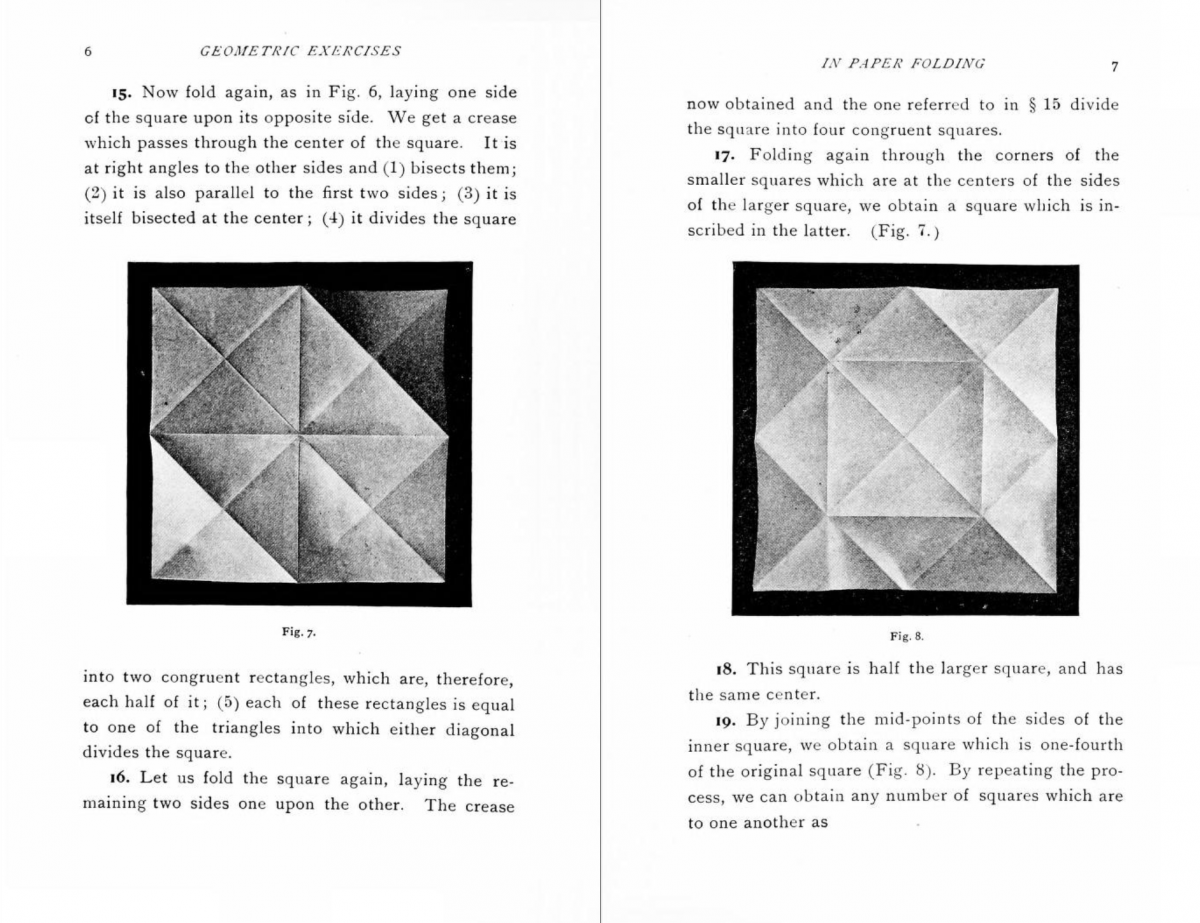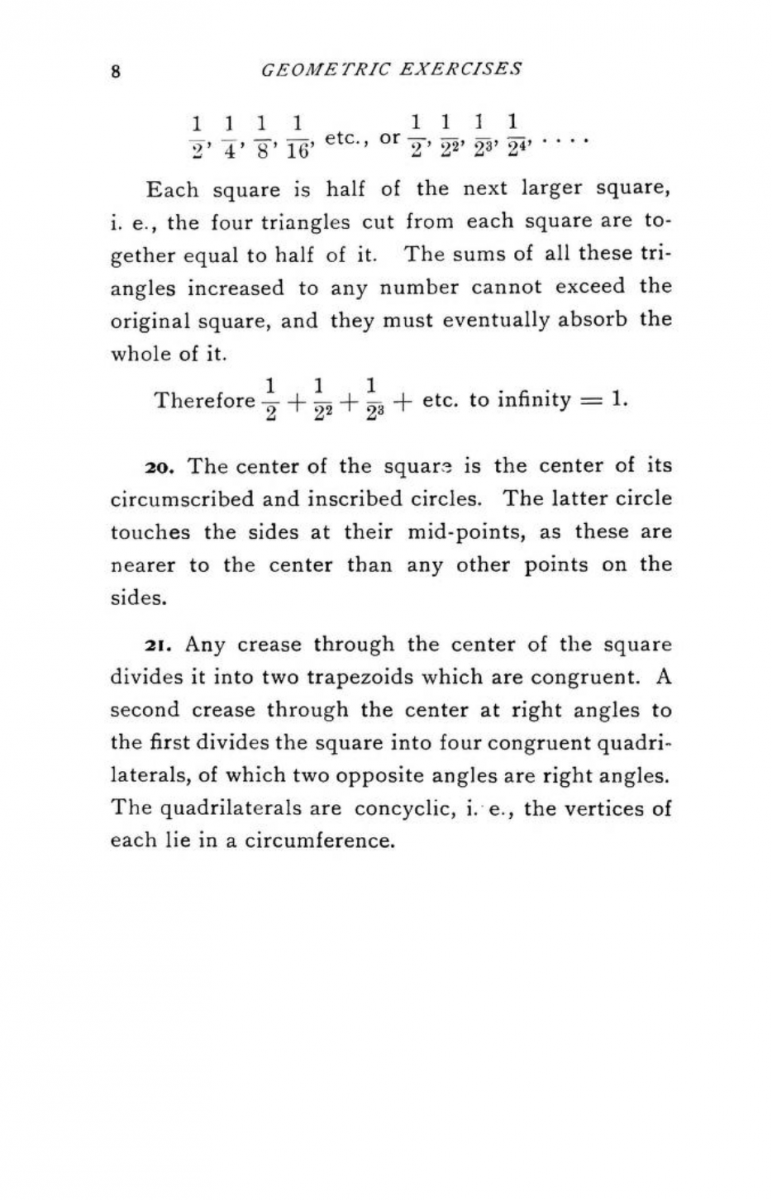- About MAA
- Membership
- MAA Publications
- Periodicals
- Blogs
- MAA Book Series
- MAA Press (an imprint of the AMS)
- MAA Notes
- MAA Reviews
- Mathematical Communication
- Information for Libraries
- Author Resources
- Advertise with MAA
- Meetings
- Competitions
- Programs
- Communities
- MAA Sections
- SIGMAA
- MAA Connect
- Students
- MAA Awards
- Awards Booklets
- Writing Awards
- Teaching Awards
- Service Awards
- Research Awards
- Lecture Awards
- Putnam Competition Individual and Team Winners
- D. E. Shaw Group AMC 8 Awards & Certificates
- Maryam Mirzakhani AMC 10 A Awards & Certificates
- Two Sigma AMC 10 B Awards & Certificates
- Jane Street AMC 12 A Awards & Certificates
- Akamai AMC 12 B Awards & Certificates
- High School Teachers
- News
You are here
Aiding the Teaching of Geometry and Affording Mathematical Recreation: Paper Folding in the Spirit of Sundara Rao of Madras – Rao’s Reprinters
As it happened, Smith and Wooster Woodruff Beman (1850–1922) of the University of Michigan beat Scott to the task of translating Klein’s Vorträge űber Ausgewählte Frägen den Elementargeometrie into English. In 1895, the pair had coauthored a textbook on plane and solid geometry, following the guidelines suggested by the AIGT [Beman and Smith 1895]. Beman and Smith would go on to publish three further textbooks with Ginn. Their translation of Klein’s book, titled Famous Problems of Elementary Geometry, included Klein’s reference to Sundara Rao [Klein 1897].[16]


Figure 15. David Eugene Smith and Wooster Woodruff Beman. MacTutor and University of Michigan.
Scott lauded Beman and Smith’s translation in the Bulletin of the American Mathematical Society [Scott 1898]. The book also received positive reviews in journals in related disciplines such as astronomy as well as in Nature [Anonymous 1898a; 1898b]. As late as 1914, Raymond Clare Archibald (1875–1955) of Brown University used the book as a starting point for a review paper on elementary geometry in The American Mathematical Monthly [Archibald 1914].
While these responses undoubtedly encouraged readers of Klein to also find out more about Rao’s book, a slightly earlier review may be more relevant to Beman and Smith’s decision to republish it in the United States. In November 1897, The Open Court, a journal edited by Paul Carus (1852–1919) of the Open Court Publishing Company of Chicago, published a short notice of Geometrical Exercises. The reviewer (writing under the Greek pseudonym μκρκ) thought that “both translators and publishers deserve the thanks of students for the reproduction of this delightful little book in English” [Anonymous 1897]. This positive review undoubtedly was known to Beman and Smith. More generally, they were aware that Open Court editor Thomas McCormack (1865–1932) actively sought new mathematical titles accessible to a relatively large number of readers.[17] Hence, when they sought to publish an edition of Geometrical Exercises in Paper Folding, they turned to Open Court.[18]
Beman and Smith had some difficulty acquiring a copy of Rao’s booklet. According to the preface to their edition of the book, to which they gave the slightly altered title Geometric Exercises in Paper Folding, they obtained a copy of the original only “after many vexatious delays.” However, by 1899 Beman had a copy in hand, and the two authors could proceed. Rao had thought his book might interest those intrigued by mathematical recreations and former geometry students, as well as those actively studying and teaching the subject. Beman and Smith envisioned a slightly narrower audience of “American teachers and students of geometry.” They were convinced that the book was “sure to be of interest to every wide-awake teacher of geometry from the graded school to the college. The methods are so novel and the results so easily reached that they cannot fail to awaken enthusiasm” [Row 1901, p. iv].

Figure 16. The title page from Beman and Smith’s republication of Row’s book. Internet Archive.
The alterations the American editors made to Rao’s text were slight. The word “geometrical” in the title became “geometric,” “equal” triangles became “congruent,” and “progressions” became “series.” Bazaars became stationery dealers, and a specific allusion to faculty at Madras University became a reference to university professors generally. Citations of specific theorems in Euclid were replaced by citations of the latest edition of Beman and Smith’s 1895 Plane and Solid Geometry. The most noticeable change was to the figures. Sundara Rao’s drawings, with black background and white lines, became either black lines on white paper or, more strikingly, halftone photographs of actual folded paper. Halftones were not commonly found in mathematics books of the time; their use here reflects Smith’s more general interest in the role of photography in teaching.


Figure 17. Beman and Smith’s presentation of the construction
for finding the sum of the geometric series \(\sum_{n=1}^{\infty} (\frac{1}{2})^n\). Internet Archive.
As one would expect from both the usual advertising practices of Open Court and the pedagogical slant of Rao’s book, teachers—especially geometry teachers—had ample opportunity to learn of the new publication. Benjamin Franklin Finkel (1865–1947), editor of The American Mathematical Monthly, described the contents of the volume in detail in the October 1901 issue of that journal. He concluded that “the work is one by which new interest may be awakened in the ever interesting and fascinating subject of geometry” [Finkel 1901]. E. M. Langley, who had reviewed the first edition of Rao’s book in the Mathematical Gazette, also noted Beman and Smith’s edition in that journal. He particularly liked the “beautifully executed photographic reproductions of paper folds.” Langley did have doubts about using paper folding as extensively as Rao proposed. As he wrote: “In our opinion the author pushes paper-folding far beyond the stage at which it is really helpful in school teaching, but perhaps an enthusiast for any particular way of doing things does good service in riding his hobby hard and thus attracting attention to its powers” [Langley 1902].
Some reviewers were less skeptical. University of Indiana mathematics professor and educator Robert Judson Aley (1863–1935), writing as editor of the Indianapolis publication The Educator-Journal, reported that “to the lover of mathematics the book is a never-ending source of pleasure and surprise; pleasure to be able to fold paper so as to prove many well-known propositions, surprise that he himself had not thought of doing it.” Aley thought the book would be of great value in leading students to the formal study of geometry and “of greater value of keeping them interested in the subject.” He commended the book to “every teacher of elementary mathematics” [Aley 1901].[19] Similarly, Dominicana: A Magazine of Catholic Literature, a journal conducted by Dominican priests in San Francisco, thought that “this novel method of teaching geometry will recommend itself to progressive teachers” [Anonymous 1902a]. Mindful of Rao’s mention of kindergarten materials, Kindergarten Magazine also reviewed the book. The anonymous commentator thought that the book would not only appeal to teachers of geometry but “will naturally attract the attention of the kindergartener [e.g. the kindergarten teacher] who has already folded the simple geometric forms, and who will readily perceive how naturally the child of kindergarten training would follow this method of proving geometrical theorems” [Anonymous 1902c].
A few more general scientific and engineering journals also mentioned Geometric Exercises in Paper Folding. Scientific American listed it among new books on 8 February 1902, echoing Smith and Beman’s comment on the value of paper folding to teachers and students of geometry [Anonymous 1902b]. The Journal of the Western Society of Engineers in Chicago commented:
It is surprising to one who has studied the geometry of our schools of (say) the last generation, to find what can be accomplished by such simple means as scraps of paper and a knife as a supplement and practical ocular demonstration of the relations between many geometric problems as laid down in the standard textbooks [W. 1901].
The reviewer not only thought that the book would be of “great assistance” to mathematics teachers, but that it discussed a remarkable range of problems.
Yet another engineer, Princeton University professor of graphics and engineering drawing Frederick Newton Willson (1855–1939), reviewed Geometric Exercises in Paper Folding for Science magazine. Willson summarized the contents of the book in considerable detail, finding it “a serviceable condensation of mathematical properties, theorems, puzzles, and problems.” He did have doubts that a student familiar with logarithms and positional geometry, as presented in later chapters of the book, would “often stop to obtain his actual results by folding.” As a professor of drawing, he also thought that use of a beveled, nickel-plated steel rule would improve the accuracy of folding. Noting the number of references to works by Beman and Smith, Willson felt led to ask “how far permission to edit carries with it advertising privileges.” Such quibbles aside, Willson found that “Where the claim of the author is so modest and his aim in so high degree attained, the task of criticism is a light one” [Willson 1902].
Finally, mathematician Virgil Snyder (1869–1950) of Cornell University also weighed in on Rao’s book. His review in the Journal of Physical Chemistry gave a concise summary of the contents and suggested that geometry teachers would find it of value “as it shows in a forcible and tangible way how properties vaguely known to us by experience are logical and necessary consequences of a few definitions” [Snyder 1902].
[16] For a more extensive listing of Smith’s publications, which mentions his textbooks in passing, see Frick [1936]. A listing that includes textbooks is Ginsburg [1926]. For Klein’s reaction to Smith’s suggestion that he publish a translation of Klein’s book, see the postcard from Felix Klein to David Eugene Smith, November 28, 1895, DESPP.
Peggy Aldrich Kidwell (National Museum of American History, Smithsonian Institution), "Aiding the Teaching of Geometry and Affording Mathematical Recreation: Paper Folding in the Spirit of Sundara Rao of Madras – Rao’s Reprinters," Convergence (March 2023)




